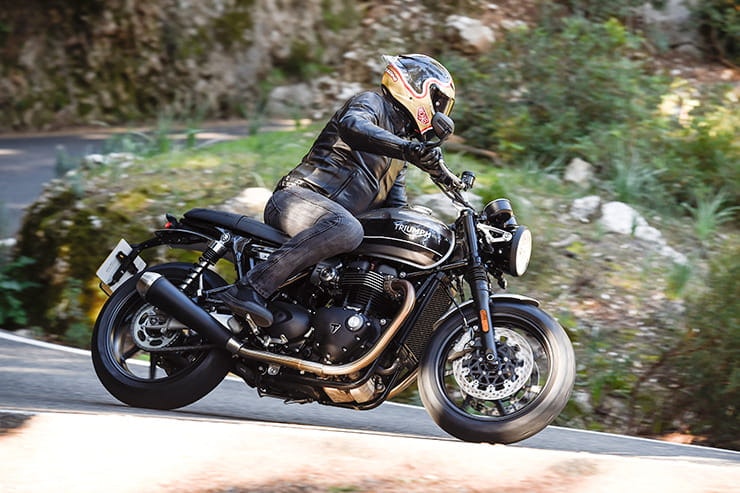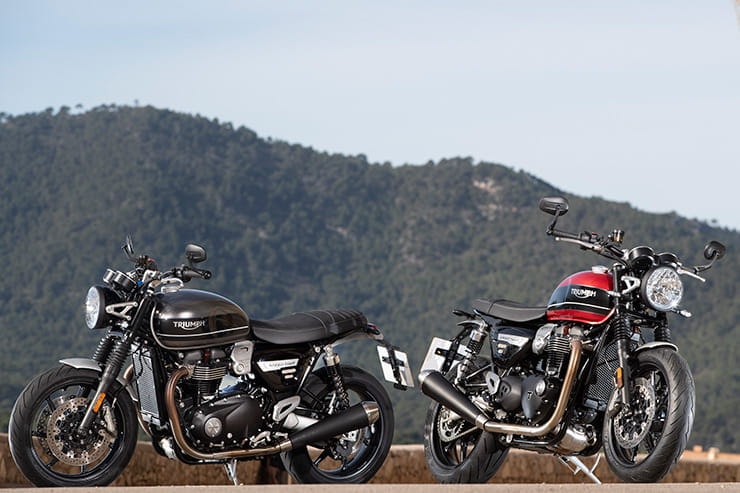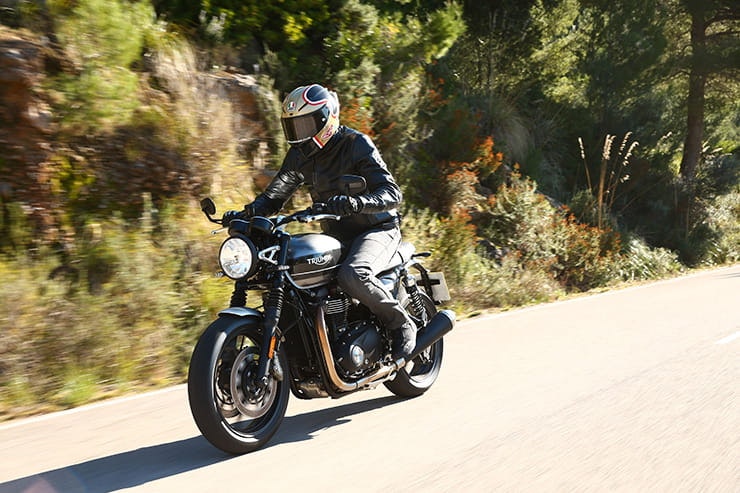Triumph Speed Twin (2019) | Review
By Michael Mann
BikeSocial Managing Editor
15.01.2019
KIT CREDITS
Jacket
Dainese Settantadue, £429.95 | www.dainese.com
Trousers
Dainese Charger, £219.95 | www.dainese.com
Boots
Dainese Street Darker Gore-Tex, £179.95 | www.dainese.com
Gloves
Dainese X-Run, £119.95 | www.dainese.com
The Triumph modern classic range grows once again with the introduction of the new 1200cc-powered roadster, the Speed Twin, which joins the Bonneville stable alongside the Thruxton, Bobber, T120 and Speedmaster, all of which use a similar liquid-cooled parallel twin motor in their slightly altered guises.
Off to the global riding launch held in Mallorca went BikeSocial’s Michael Mann for the first review of the new £10,500 Triumph Speed Twin. Don’t be fooled by its classic appearance, this is a lithe-enough animal, laden with plenty of technology and certainly not just a Thruxton with flat bars.
Three colours in the range though it’s only the fuel tank that changes
2019 Triumph Speed Twin Price
Priced to compete with rivals from BMW and Kawasaki but also to fit into the existing modern classic Triumph range, the three colour options are available from £10,500 for the Jet Black option, plus an extra £300 for either of the Korosi Red/Storm Grey or my favourite, the Silver Ice/Storm Grey colours, both of which have hand-painted coach lines.
The new Speed Twin is available in Triumph dealerships from the end of January 2019 so go get your test ride booked, you won’t regret it. Unless it’s snowing. I would imagine it’s rubbish in the snow.
VIDEO - First Impressions Triumph Speed Twin (2019)
New-for-2019, the 1200cc Triumph Speed Twin is tested on the press launch by BikeSocial's Michael Mann.
Just look at that flat torque curve
Power and torque
In a blow to lovers of that comparison card game, Top Trumps, in recent years Triumph have focused more on torque figures and how they are reflected in the bike’s performance instead of the out-and-out BHP power digits. So, while the Speed Twin can unleash a claimed 96bhp (71.5 kW) at its peak of 6750 rpm, down on its nearest competitors from BMW, Kawasaki and Yamaha, it’s the 112Nm (82.6 lb-ft) at 4950rpm that has our attention. Why? Because the torque curve isn’t really a curve, it’s more of a flat line, which in essence means there’s at least 100Nm of torque all the way through the rev range. From what is pretty much tickover at 2,500rpm to the red line at 7250rpm.
It means the majority of corners can be taken in third gear such is the lovely smooth application of power when twisting that throttle grip as the bike stands up. Open it right up and the reward is the continuous pull as the bike gallops through the revs as if it were fresh out of the stalls at the Grand National. Deploy a small amount of clutch, feed another gear in and feel the grunt once more, like a strongman pulling a bus as it heaves its 197kg (plus fluids and rider) and devours the rpm’s again. It too means the mid-range is plentiful for an overtake without dropping a gear.
Resplendent and retro-looking parallel twin with a sublime exhaust run for added detail quality
Engine, gearbox and exhaust
The booming parallel twin cylinder engine offers not only the rider but anyone within earshot such acoustic joy. Ask any toddler to make the sound of a helicopter and then add a bit of bass and slow it by 50% (go on, try it) and you’re nearly matching the deep throb from the 1200cc, ‘High Torque’ Triumph engine also seen in the Bobber, Bobber Black, Speedmaster, T120 and, of course, Thruxton.
After all, the plan for the Speed Twin when it began as a project for Triumph’s engineers three years ago was to take the power, torque and technology of the Thruxton R and make it even more accessible with a modern set-up. Take 10kg away, replace the chassis, suspension, brakes and add a few neat technology-based features here and there and while the new machine has all the hallmarks of the Thruxton, unveiled back in 2015, it’s a slightly revised ballgame, rather than a whole new one.
There’s always torque from this engine, whatever gear you’re in and however many revs you’re at, the throttle action is responsive enough but it’s that sweet looking engine that offers the required and reactive surge.
Three engine maps, power modes, or even rider modes, call them what you will, are available at the touch of a rather obvious ‘Mode’ button on the left-side of the handlebar. The mode can be changed on the fly and only requires a one-second close of the throttle and dip of the clutch once the mode has been selected. Switching between Rain, Road and Sport doesn’t affect the overall power figures but does alter the throttle body opening and traction control settings. Out on the open roads and for some aggressive riding then opt for Sport, which is my natural default, but for around town then I had no hesitation switching to Road which offers a less jerky on and off throttle response giving a smoother ride.
The six-speed gearbox hosts a tall top gear that is only required on the motorways, long, straight stretches of A-road or if you like being super-conservative on fuel. The first three gears do find themselves reaching the redline quickly when riding in the style suited to the silhouetted poise of this classic-looking yet modern roadster.
Plenty of ground clearance with those high foot pegs
2019 Triumph Speed Twin Economy
Those responsible for the weight saving part of the Speed Twin project must have felt as though a larger fuel tank would add too much to the 197kg (dry) and upset the balance and weight distribution of the bike. So, while a full 14.5-litre tank is claimed to take you 180-miles with an economy of 59mpg, I beg to differ. I witnessed a brimmed tank fuel of unleaded which, admittedly a press launch is never an exercise in economic riding, allowed me to cover but 81-miles before the orange light of doom began to shine and the on-board display showed a range of 30-miles remaining. Incidentally, when full the range reads 136-miles. So, according to the digital part of the Triumph’s classically stylish twin clock set-up, my economy was 45.1mpg.
Either way, the comfort of the seat and peg position will prevent any rider from blasting out a 100+ miler in a single non-stopping ride.
Would you change its appearance?
Handling, suspension, chassis and weight
One of the first questions I asked at the bike’s unveiling in Paris at the beginning of December was around an ‘R’ model. I mean the Thruxton had an R version with swish suspension and a brake upgrade so I though the Speed Twin would be the ideal base from which Triumph could pimp. Turns out, they really don’t need to. The KYB suspension on paper isn’t plush enough for some yet after a 150-mile press launch ride, which is traditionally held at a slightly more intense pace, and the 41mm forks with their 120mm travel suspended the latest Triumph with grace. For all their contribution to the agility and handling of the geometrically spot-on motorcycle, they aren’t adjustable. Not a concern for me but maybe for others. Meanwhile, at the back, the twin shock KYB set-up also has a travel of 120mm but is adjustable for spring preload. Again, I was more than comfortable with the standard settings.
Chassis-wise and the magnesium cam cover, revised clutch assembly, new battery and cast aluminium wheels all contribute to that 10kg saving (7kg over the Thruxton R) plus the fact that the frame itself is new. It’s been developed from the Thruxton frame and is only fractionally longer in the wheelbase to aid stability, achieved by simply extending the chain setting.
Once the necessary fluids have been added to the 197kg dry weight and the Speed Twin begins to look like a big bear, on paper at least. But, like a heavyweight hopping from one foot to the other in the first round, it carries its weight well. It’s precise enough in the corners without challenging for apex-hunting glory – not its natural habitat - yet once you’ve got some momentum through the quicker corners and the Speed Twin can be proud of its level of dexterity.
Not that it needs many more cool points, although some would argue over the so-called suspension gaiters, I think a wider tyre profile on the rear would make the bike look slicker still.
Brembo-equipped front brake, the rear has a Nissin caliper
2019 Triumph Speed Twin Brakes
Four-piston Brembo calipers clamp onto the twin 305mm discs yet for such high-end components, the feel of the brakes is only at that point between very good and great, they’re not sharp enough at the initial bite for my liking and decelerating enough before heading into some sharper corners took more effort than I expected. A little extra pressure on the lever didn’t seem to upset the suspension dive at the front but trail braking had to be carefully balanced with a combination of reasonably new tyres, the weight affecting braking more than I anticipated and some slippery surfaces in the tree lined roads around the Mallorca mountains.
A narrow waist offers accessibility while a wider rear suits a pillion (try saying that without referring to a motorcycle seat)
Comfort over distance and touring
A narrow waisted seat with a height of 807mm sounds like a winning combination for accessibility, and the Speed Twin certainly has a favourable seat position for those shorter in the leg. However, even though the foot pegs have been moved 38mm forward and 4mm lower than the Thruxton for a more relaxed riding position, my six-foot frame felt a little cramped after 30-miles or so. Enough for a good old leg stretch anyway.
That said, having the pegs so high means there’s plenty of ground clearance so you’d have to going at a fair rate with some confidence in the tyres to get the pegs scraping. A quilted seat is available as an official accessory in either brown or black and I hope it offers a degree of added comfort because I’d want to be stopping after a single journey of 50-miles.
In terms of the rider’s poise on the bike, while the Sped Twin is undoubtedly a good-looking machine without a rider, with one on it seems to emphasise the stance of higher rear end leaning down.
Add a pillion into the equation and even though the seat widens at the rear and contains the necessary pillion grab strap, all of a sudden a 1200cc motorbike begins to look small. The 80-strong official accessory range features one piece of luggage – a tank bag – so even Triumph aren’t expecting any significant touring efforts here.
The bar-end mirrors are to everyone’s taste but in terms of doing their job, they couldn’t be much better. Easily adjustable, stable with a good range of vision and they’re vibe free. Trouble is, they’re the widest part of the bike and are located at the perfect height for clipping wing mirrors when dissecting city traffic or filtering on a slow moving dual carriageway.
Rider aids and extra equipment / accessories
The traditional sit-up-and-beg style of this Bonneville roadster hides a multitude of high-class engineering and modern day kit. Of course, Triumph have deservedly played their ace card once again and treated us to an aesthetically beautiful twin exhaust run from the headers down and out through the polished aluminium silencers which on first glance don’t look like they’ve been interrupted by a visit the Euro-4 spoiling catalytic convertor. But they have, and Triumph have hidden it well.
Rider modes, switchable traction control, two trips, a fuel range, economy and gear position indicator are all useful and thankfully part of the digital part of the LCD multi-functional instrument pack. Other than the usual switches, an ‘i’ and ‘Mode’ can also be found which offer simple operation for the options on the display.
It’s all simple and user-friendly to get operate and get familiar with, there’s even a semi-handy USB charging point under the seat. I say ‘semi’ because there’s nowhere under the seat to actually store your phone!
Rivals
Taking its classic roadster appearance and mixing in power and price, the non-existent computerised make and model competitor generator, aka me, came up with the following foursome as the nearest contenders other than the Speed Twin’s own stablemates and engine sharers, the T120 and Thruxton:
2019 Triumph Speed Twin verdict
Overall, the Speed Twin is a hoot to ride. It’s a strong, sturdy feeling machine that is hard to unsettle, handles any radius of corner with stylish aplomb and has a bootful of torque to drive through the gears, revs and speed. Limited comfort and economy aside, it’s difficult to fault. Triumph have triumphed with a stylish, classy, punchy bike that nestles among its Bonneville family tree though realistically shoves the T120 out into the cold.
Three things I loved about the 2019 Triumph Speed Twin …
Smooth, gutsy torque available all through the rev range
Bellowing sound
Looks very cool
Three things that I didn’t…
Small tank range
Front brake is good, not great
Cramped leg position
2019 Triumph Speed Twin spec
To insure this bike, click here
To learn more about what the spec sheet means, click here for our glossary


